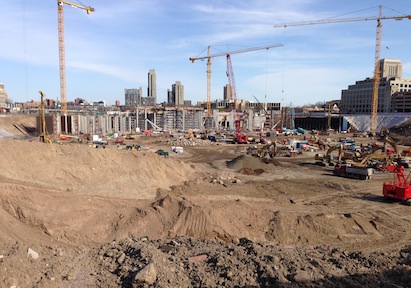Due to the weather-related slow start in the nonresidential building market during the first part of the year, and the prolonged weakness in the institutional sector, construction spending projections for the rest of the year have been lowered slightly.
The commercial construction sector is still looking at solid spending increases throughout the remainder of 2014, paced by high levels of demand for hotels and office buildings. The American Institute of Architects’ (AIA) semi-annual Consensus Construction Forecast, a survey of the nation’s leading construction forecasters, is projecting that spending will see a 4.9% increase in 2014 – down from the previous estimate of 5.8%, with next year’s projection holding at 8%.
VIDEO: AIA Chief Economist discusses economic trends for 3rd quarter of 2014
“The institutional market has been a drag on the overall recovery for the design and construction industry for the last few years, and until we see state and local governments ramp up spending for new education, healthcare and public safety structures there likely won’t be a widespread acceleration in spending for the entire industry,” said AIA Chief Economist, Kermit Baker, PhD, Hon. AIA. “But we continue to have an optimistic outlook for the commercial and industrial sectors both for the rest of this year and into 2015.”
|
Market Segment Consensus Growth Forecasts |
2014 |
2015 |
|
|
|
|
|
Overall nonresidential building |
4.9% |
8.0% |
|
|
|
|
|
Commercial / industrial |
9.9% |
11.2% |
|
Hotels |
14.5% |
9.2% |
|
Office buildings |
12.8% |
13.3% |
|
Industrial facilities |
7.6% |
9.2% |
|
Retail |
7.4% |
10.4% |
|
|
|
|
|
Institutional |
-0.1% |
5.8% |
|
Amusement / recreation |
3.7% |
6.6% |
|
Education |
-0.1% |
5.7% |
|
Healthcare facilities |
-1.8% |
6.6% |
|
Religious |
-4.1% |
0.7% |
|
Public safety |
-4.2% |
3.3% |
Baker continued, “While there does not appear to be any structural frailties in the overall economy that could possibly derail increasing levels of construction spending over the next 18 months, lending standards at financial institutions continue to fall well short of the increasing demand for commercial real estate loans, which is another factor that serves as a wild card and a source of concern for the entire industry.”
About the AIA Consensus Construction Forecast Panel
The AIA Consensus Construction Forecast Panel is conducted twice a year with the leading nonresidential construction forecasters in the United States including, McGraw Hill Construction, Wells Fargo Securities, IHS-Global Insight, Moody’s economy.com, Reed Business Information, Associated Builders & Contractors and FMI. The purpose of the Consensus Construction Forecast Panel is to project business conditions in the construction industry over the coming 12 to 18 months. The Consensus Construction Forecast Panel has been conducted for 15 years.
About The American Institute of Architects
Founded in 1857, members of the American Institute of Architects consistently work to create more valuable, healthy, secure, and sustainable buildings, neighborhoods, and communities. Through nearly 300 state and local chapters, the AIA advocates for public policies that promote economic vitality and public well being. Members adhere to a code of ethics and conduct to ensure the highest professional standards. The AIA provides members with tools and resources to assist them in their careers and business as well as engaging civic and government leaders, and the public to find solutions to pressing issues facing our communities, institutions, nation and world. Visit www.aia.org.
Related Stories
| Aug 11, 2010
New book provides energy efficiency guidance for hotels
Recommendations on achieving 30% energy savings over minimum code requirements are contained in the newly published Advanced Energy Design Guide for Highway Lodging. The energy savings guidance for design of new hotels provides a first step toward achieving a net-zero-energy building.
| Aug 11, 2010
Perkins+Will master plans Vedanta University teaching hospital in India
Working together with the Anil Agarwal Foundation, Perkins+Will developed the master plan for the Medical Precinct of a new teaching hospital in a remote section of Puri, Orissa, India. The hospital is part of an ambitious plan to develop this rural area into a global center of education and healthcare that would be on par with Harvard, Stanford, and Oxford.
| Aug 11, 2010
Burt Hill, HOK top BD+C's ranking of the nation's 100 largest university design firms
A ranking of the Top 100 University Design Firms based on Building Design+Construction's 2009 Giants 300 survey. For more Giants 300 rankings, visit http://www.BDCnetwork.com/Giants
| Aug 11, 2010
PBK, DLR Group among nation's largest K-12 school design firms, according to BD+C's Giants 300 report
A ranking of the Top 75 K-12 School Design Firms based on Building Design+Construction's 2009 Giants 300 survey. For more Giants 300 rankings, visit http://www.BDCnetwork.com/Giants
| Aug 11, 2010
Turner Building Cost Index dips nearly 4% in second quarter 2009
Turner Construction Company announced that the second quarter 2009 Turner Building Cost Index, which measures nonresidential building construction costs in the U.S., has decreased 3.35% from the first quarter 2009 and is 8.92% lower than its peak in the second quarter of 2008. The Turner Building Cost Index number for second quarter 2009 is 837.







